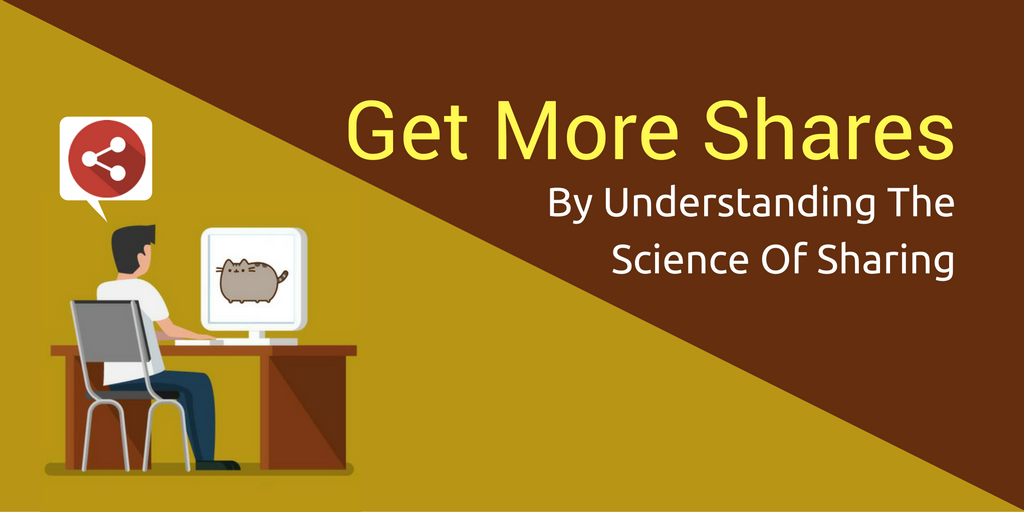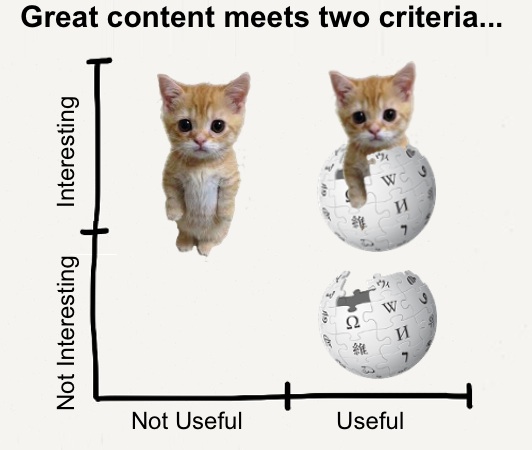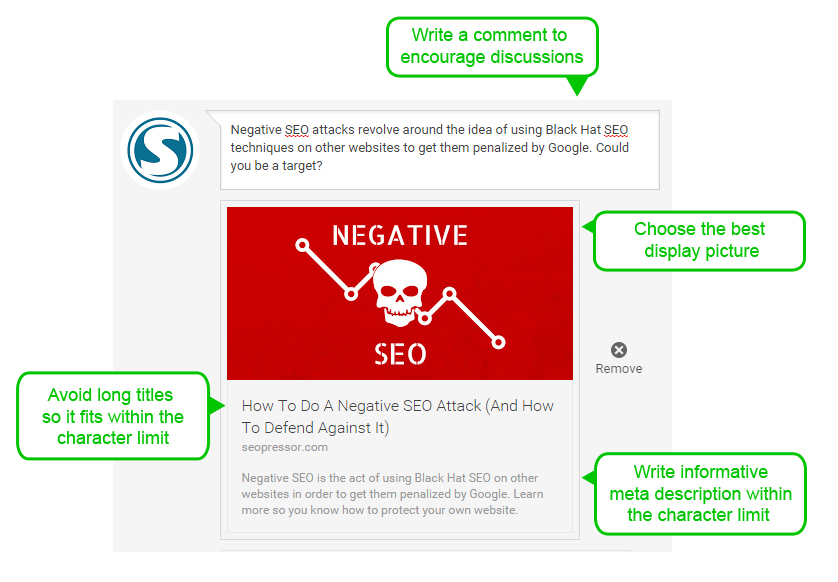Steph W. from SEOPressor


...help you check your website and tell you exactly how to rank higher?




...help you check your website and tell you exactly how to rank higher?



SUBSCRIBE TO SEOPressor BLOG
Join 50,000+ fellow SEO marketers!
Get SEOPressor latest insights straight to your inbox.
Enter your email address below:
92
score %
SEO Score

Found us from search engine?
We rank high, you can too.
SEOPressor helps you to optimize your on-page SEO for higher & improved search ranking.
By winniewong on September 30, 2016

Shares are essential to building your audience, and are one of the most influential ways you can reach new people. Individuals share articles on social media, meaning their share serves as a form of endorsement and recommendation of the content.
But sharing is a much more complex idea that it may first appear, and the reasons behind sharing are as diverse and varied as the individuals sharing.
By understanding why people share content, we as content marketers can better tailor our content to what is most likely to get people sharing. What’s more, we have to understand how to get people to read content once it has been shared.
The blog IFLScience recently caused controversy among readers by baiting them with a fantastical headline, which led to a discussion of how likes, shares and comments all occur without people having read the article.
There’s some useful stuff in there. Columbia University and the French National Institute found 59 percent of links shared on Twitter weren’t clicked by followers. The instinct to share is strong, but the instinct to read what people share is far less potent.
If we’re going to do our jobs more effectively, we need to understand the psychology of sharing. Then, we need to harness the positives and find workarounds on the negatives in order to ensure our content is performing at peak potential.
When considering how to get more shares, we need to look at the underlying motivations that create sharing behaviour. Fortunately for us, the New York Times has already undertaken groundbreaking research into this field.
Fortunately for you, I’ve read the research and can give you the short version here, to save you the time of poring over academic papers and slides.
There’s evidence to suggest sharing behavior actually helps people process information better. In the same way that universities use seminars as well as lectures, talking about content online can help people get their head around what it’s trying to say by discussing it with others.
The comments and reactions to an article are also useful signalling tools (and these are used in several different ways). Comments and responses to articles can help people create a three-dimensional view of the topic as the original author is challenged or supplemented by additional information.
In its simplest form, sharing can also be a way to bookmark links to be read later on. This also allows information to accrue in the meantime as people comment, so individuals can start with an enriched view of the content.
Theories on altruism and utility come into play here. Essentially, being nice helps us survive because if we help people when they need it, they’ll help us when we need it. It’s not a perfect system, but it’s survived because it’s helped us to thrive. Altruism also helps us show our value within our community.
As such, people will often share content they encounter if its relevant and helpful for their networks. This helps them demonstrate their own value, and being a high-level curator of content is now as impressive as creating content yourself.
As well as demonstrating their own worth and value to their networks, it helps build relationships. If you remember a problem someone’s facing and share an article with the solution, it shows you care. Bonding through sharing.
Arguably, this may be the single most influential factor in this list. Self-image is an incredible potent thing in today’s society, and selectively sharing articles can help people cultivate that self-image on social media. Individuals can express their interests and passions, as well as their own expertise, through the kind of content they share.
People also share to reinforce and promote their existing beliefs about the world, which is one of the biggest reasons for the unfortunate “echo chamber” effect people are experiencing on Facebook and Twitter these days.
Often, shares motivated in this way will be include emotive and passionate stances on hot button issues. Because most people aren’t writers, they’re seeking someone who can articulate their thoughts for them in a more polished, heightened way than they can say it themselves.
Social grooming is a practice observed in most mammals, but is practically absent in human beings. Instead of physical content, we often share thoughts and ideas. Sharing content is a way for people to keep their relationships engaged by sharing posts on topics that link to memories, events and shared interests within social groups.
By discussing content on social media, individuals can keep their relationships with people alive remotely – increasingly essential in the busiest generation of all time. What’s more, sharing content can help people feel a part of something without actually being there, to remove the ‘fear of missing out’ (FOMO) that our busy lifestyles create.
We also share to help share feelings with people. Sharing things that make us feel good helps others to feel good, and positive reinforcement is a powerful tool in maintaining healthy relationships.
This might be the noblest reason people can share content, but it rings as slightly disingenuous, and I’m sure has ties with several of the other reasons we’ve already discussed. Nevertheless, self actualisation is the pinnacle of human pursuits, and sharing content can be a part of it.
Sharing content can help people feel like they’re taking part, and engaged in something. It also helps people feel smarter or cooler: the simplest example of this would be ‘share when you see it’, which creates an in-group that suggests those who have cracked the puzzle are better than those who haven’t.
People also like to feel useful (see point Number 2) and often the feeling of sharing mirrors that of helping people, even if the audience is completely broad and untargeted. Emotive, philosophical or novel content like TED Talks are a prime example of how people can feel they are enriching themselves and others just by sharing.
People love to champion causes. One of the most interesting examples of this was the strange case of Kony 2012, called the most viral video of all time until the advent of Gangnam Style. People want to make a difference and believe ‘raising awareness’ helps them do that in a meaningful yet energy efficient way. The ALS Ice Bucket Challenge, 22 Kill, and more have all taken the viral campaign strategy to heart to get huge shares.
Another example of evangelism is in promoting brands that have delivered for the customer. People who experience a game changing product or service will share that content so that other people can benefit from the same great experience. This should be your ultimate goal if you’re a product based business. If you can make your product pay off emotionally, you
recruit armies of sharers.
These are the biggest reasons that people share content online, and just by absorbing this information and letting it settle into the back of your mind, you should find it starts to change your approach in subtle ways.
That said, if you want to take a targeted and strategic approach to creating dynamic shareable content, then there are concrete actions you can take to successfully take advantage of these qualities for best success.
Making content more shareable using this knowledge can be more difficult than it may seem. This is because these motivations all overlap, combine or even conflict with one another within a single topic area. As such, you need to serve several agendas at once to effectively optimize content for sharing.
Fortunately, all the things you need to do to make content share-worthy go hand in hand with what you need to do to make your content awesome. So that’s a relief.
I can’t emphasise this enough. As a writer, your utility is communicating things of value. That’s two things – the content and how you present it. Before you get onto the presentation, your content needs to really matter.
In good storytelling, a character changes in response to challenges that need to be overcome. In the story of your article, the reader is the main character. They should have changed by the time they’ve finished reading. This of course will be in a small way, but if they know something they didn’t before, then the article has value. You need to maximize that value to maximize shares.
Once people understand that this is content that can change them, they’ll share it. Both for easy future reference for themselves, and to enable their networks to benefit from it.
It takes skills, experience, expertise, and a whole load of mental energy to get through an academic article. But you can talk for hours with your friends easily.
You want to be a friend to your audience, not a lecturer. Chill out on the hard words and superior tone. If you can be casual, entertaining, and put in a dash of humor here and there, you’ll keep your audience buoyant and engaged. They’ll be learning, but they won’t feel like they’re in a classroom.
You have to be able to get this balance right.

As content marketers we naturally assume we’re supposed to have all the answers. After all, we base so much of what we do on authority. In fact, questioning your readers can help to generate shares.
Moral quandaries are a great example of this effect. These are thorny issues that have no easy answer, and take a lot of grappling with to come to a conclusion. People share these because they want to know what other people think before making a decision themselves.
Curiosity is our natural state. Questions without an easy answer hijack this curiosity and make people seek answers elsewhere, taking our content with it.
Half of this article, this half to be precise, is all about what you can do with the knowledge you’ve gained. Talking about something is only ever half as compelling as doing something. Make your content actionable.
More importantly, make your content achievable.
Huge solutions that require Herculean feats of will and commitment simply don’t fly these days. People want fast ways to get a little better, not epic transformations that take months to achieve.
I’ve seen this called the Karate Kid Effect by David Wong over at Cracked. We’ve grown up watching training montages, which boil down the hardship and effort it takes to achieve something into a couple of inspirational minutes. By doing so, it completely warps our sense of how difficult it is to do anything, and we can’t believe it’ll take us more than those inspirational two minutes.
So give people pointers and simple ideas they can fold into their existing lives, and they’ll get shared. Just look at the popularity of life hacks, designed to ‘cheat’ life to make it easier.
Full disclosure: it hasn’t actually been proven, but neither has it been disproved. What we DO know is that people will share content based on the title alone. The IFLScience article I linked to earlier was called:
“Marijuana Contains Alien DNA From Outside Our Solar System, NASA Confirms”
The point of this was to see who would comment, like and share the article without reading it. They will do so because it is an extraordinary claim that contains the full story in summary, that uses the name of a trusted authority to back up the claim. If the article was about what it says it is (and why wouldn’t it be?) there’s actually no need to read the article.
As a content marketer, you of course want people to actually read the content. This is where creating a curiosity gap, or clickbait headline, might help. The equivalent clickbaited title might read:
“NASA Confirms Unbelievable Fact About The Alien Nature Of Marijuana”
What is the fact? Why is it unbelievable? Then people would click, because the most valuable information is withheld.
My personal recommendation would be somewhere in the middle. Make a clear promise of value to the reader, make it emotive and exciting, but don’t tell the whole story.
The classic adage goes something like this:
“There are two keys to success:
One, don’t tell people everything you know.”
This is just as true for titles, if you want people to actually read the content. If you want to maximize knee-jerk shares however, it might be worth it.
Open Graph meta tags can help you customize how your content looks on social media to a much greater extent than is possible by simply copy and pasting the link into the post box on Facebook or Twitter.
With tags for the title, image, and description, individuals can customise the look of their article on social media to ensure it is being presented in the best and most compelling way.

Also important in getting others to share is to start sharing your posts! Some of you might think this is obvious – many more will think it’s the audience’s responsibility to share. Think of it this way, if you don’t, why should they?
One of the most important things you can do is to accompany your content with a different message on different platforms, taking advantage of the kind of audiences most likely to use that platform.
It’s also important to recognize the different networks available. I’ve already written on how you can boost your post reach by 655% using Google Plus.
Team Cap, Team Iron Man. Team Valor, Team Instinct. Picking a side is a powerful tool in marketing.
If you’re talking about a polarizing subject, the only thing that will annoy readers more than coming down on one side is not picking a side at all. You need to decide where you stand and come out strongly in defence of that stance.
When you do, those who agree with you will share your posts because you’re endorsing their viewpoint.
Those who disagree with you will share your article to call you out and enlist their social groups to challenge you in comments and discussions.
All of this results in more traffic.
Tribalism is the cause of a lot of the world’s problems, and the lurch toward globalisation has created an equal lurch backward into tribal behavior, contributing to everything from ISIS to Donald Trump. So there’s no disputing it’s power.
You can harness that power harmlessly and for the benefit of readers by using it to get your work out there.
There’s a relationship between the value your content has and the complexity of the topic you’re wrestling with.
The real skill you can develop as a writer is to be able to present complex topics in simple terms.
If you need help understanding what I’m talking about, Dr. Brian Cox from the BBC series Wonders Of The Universe does it all the time. That’s him using a spring to explain why atoms are empty.
Steering clear of jargon, and using concrete examples people can easily understand, will help readers ‘get it’ quicker. This will trigger a reward response in your audience. You will help them feel smarter, because they’ve understood something they didn’t before.
You ‘unlocking’ complexity for them will make them way, way more likely to share. That’s why it’s essential you keep your tone clear, conversational and concise.
We’ve talked about on trend versus evergreen content before (LINK TO: Azfar Evergreen Content Article), but to keep it short: on trend content is an essential part of any successful content marketing strategy.
With enough creativity, any major trend can be tied into your niche, or at the very least, affect it in some way.
By doing this, you anchor your site and your product to things people are already talking about. This makes it much easier to gain traffic, as people will be hungry for content on those hot button topics.
By taking a strong stance and offering a unique perspective, you can change the way people see trending topics and successfully achieve many of the objectives we’ve set out here, all while knowing the audience is hungry to read the content. Get it right, and it’s a sure thing.
We’ve taken a journey through why people share, and what we can do to encourage them to do so. What have we learned?
If I had to boil it down to one thing, it would be this: connectedness.
Relationships are important to sharing. People share to make themselves valuable and desirable, they share to help others and they share to champion the things they believe in.
Even the ‘selfish’ reasons are based on improving something, whether it be their understanding or their status.
That means sharing is unquestionably a positive thing. Understanding that people are seeking positive reasons to share is essential in defining your content to deliver those positive reasons.
Help people understand. Share discoveries. Make people laugh. Help people achieve something. These are all exciting things to be a part of, and should make you excited about writing your content.
If you’re excited to write it, your readers will be excited by it, and share that excitement with others. You’re involved in an exchange of energy – your expertise for their loyalty. If you play your cards right, you can become the cause your audience wants to champion.
Keep these things in mind when you’re writing, and write toward that end. It won’t just make people share your stuff more, it’ll make your articles better. It’ll make the job easier, and make the articles more fun to write and to read. There are challenges, for sure, but the rewards are more than worth it.
Updated: 29 December 2025

Winnie is an aspiring copywriter & internet marketer in the vast world of digital marketing. She's as curious as she can be; constantly hunting for answers to her questions, never saying no to new experiences. When she's not spending her time typing up a storm, she is at home keeping up with her never-ending movie marathon & books.
Struggling with internal linking?
Wish you could...

Automate internal linking

Use optimized anchor text

Fix 18 issues like orphan pages

Get link reporting and analytics
Precise, Simplified, Fast Internal Linking.


Save thousands of dollars (it’s 100x cheaper)

Zero risk of Google penalty (it’s Google-approved)

Boost your rankings (proven by case studies)
Rank High With This Link Strategy
Precise, Simplified, Fast Internal Linking.


Subscribe and receive exclusive insider tips and tricks on SEO.
Delivered to you right from the industry’s best SEO team.
Copyright © 2025 SEOPressor. All Rights Reserved.
Powered by Semantics BigData Analytics (SBDA).
